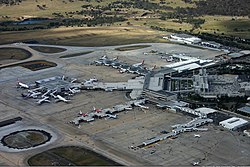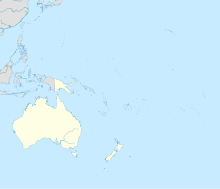
Back Melbourne-lughawe Afrikaans مطار ملبورن الدولي Arabic Aeropuertu Internacional Tullamarine AST মেলবোর্ন বিমানবন্দর Bengali/Bangla Melbourne Airport (tugpahanan) CEB Letiště Melbourne Czech Maes Awyr Melbourne Welsh Melbourne Lufthavn Danish Flughafen Melbourne German Aeropuerto Internacional Tullamarine Spanish
Melbourne Airport Melbourne–Tullamarine | |||||||||||||||
|---|---|---|---|---|---|---|---|---|---|---|---|---|---|---|---|
 | |||||||||||||||
 | |||||||||||||||
| Summary | |||||||||||||||
| Airport type | Public | ||||||||||||||
| Owner/Operator | Australia Pacific Airports Corporation (APAC) | ||||||||||||||
| Serves | Melbourne | ||||||||||||||
| Location | Melbourne Airport, Victoria, Australia | ||||||||||||||
| Opened | 1 July 1970 | ||||||||||||||
| Hub for | |||||||||||||||
| Operating base for | |||||||||||||||
| Elevation AMSL | 434 ft / 132 m | ||||||||||||||
| Coordinates | 37°40′24″S 144°50′36″E / 37.67333°S 144.84333°E | ||||||||||||||
| Website | www | ||||||||||||||
| Maps | |||||||||||||||
 | |||||||||||||||
 | |||||||||||||||
| Runways | |||||||||||||||
| |||||||||||||||
| Statistics (2022–2023) | |||||||||||||||
| |||||||||||||||
Sources: Australian AIP and aerodrome chart[5] Passengers and aircraft movements from the Bureau of Infrastructure & Transport Research Economics | |||||||||||||||
Melbourne Airport (IATA: MEL, ICAO: YMML), known locally as Tullamarine Airport, is the main international airport serving the city of Melbourne, the capital of the Australian state of Victoria. It is the second busiest airport in Australia. The airport operates 24/7 and has on-site parking, world-class shopping and dining. The airport opened in 1970 and replaced Essendon Airport. Melbourne Airport is the main international airport of the four airports serving the Melbourne metropolitan area, the other international airport being Avalon Airport.
The airport comprises four terminals: one international terminal, two domestic terminals and one budget domestic terminal. It is 18 kilometres (11 miles) northwest of the city centre, adjacent to the suburb of Tullamarine. The airport has its own suburb with its own postcode—Melbourne Airport, Victoria, 3045 respectively.[6] The facility presently covers 2,741 hectares (6,773 acres) of airport property, making MEL among the largest airports in Australia in terms of land area.[7]
In 2016–17 around 25 million domestic passengers and 10 million international passengers used the airport.[8] The airport features direct flights to 33 domestic destinations and to destinations in the Pacific, Europe, Asia, North America and South America. Melbourne Airport is the number one arrival/departure point for the airports of four of Australia's seven other capital cities.[a] Melbourne serves as a major hub for Qantas and Virgin Australia, while Jetstar utilises the airport as home base. Domestically, Melbourne serves as headquarters for Team Global Express and handles more domestic freight than any other airport in the nation.[10]
- ^ Marsh, Stuart (15 February 2022). "Incoming budget carrier Bonza announces 25 routes to 16 destinations". Nine News. Retrieved 16 March 2022.
- ^ "Melbourne Airport June 2023 and FY22/23 passenger performance". Bureau of Infrastructure and Transport Research Economics. Retrieved 4 March 2024.
- ^ "Airport traffic data". bitre. Bureau of Infrastructure & Transport Research Economics. Retrieved 4 March 2024.
- ^ a b "Airport Economic & Social Impact Report 2023". Melbourne Airport. Retrieved 4 March 2024.
- ^ YMML – Melbourne (PDF). AIP En Route Supplement from Airservices Australia, effective 21 March 2024, Aeronautical Chart Archived 10 April 2012 at the Wayback Machine
- ^ "Suburbs in postcode 3045 – Australia Post Codes". Auspostcode.com. Archived from the original on 7 July 2011. Retrieved 30 May 2011.
- ^ "Melbourne Int'l Airport 2022 Master Plan (pgs.17,64,73,74)". melbourneairport.com.au. Retrieved 15 November 2023.
- ^ "Airport traffic data: 1985–86 to 2021-22". Bureau of Infrastructure, Transport & Regional Economics. Archived from the original on 20 October 2019. Retrieved 5 November 2022.
- ^ "Australian Domestic Aviation Activity 2017–18". Bureau of Infrastructure & Transport Research Economics. September 2018. Archived from the original on 2 April 2019. Retrieved 13 December 2018.
- ^ "2003 Annual Report" (PDF). Melbourne Airport. 2003. Archived from the original (PDF) on 24 July 2008. Retrieved 30 June 2008.
Cite error: There are <ref group=lower-alpha> tags or {{efn}} templates on this page, but the references will not show without a {{reflist|group=lower-alpha}} template or {{notelist}} template (see the help page).
© MMXXIII Rich X Search. We shall prevail. All rights reserved. Rich X Search



